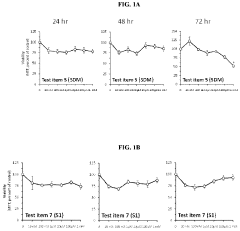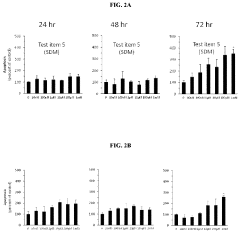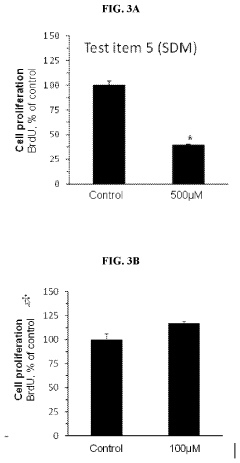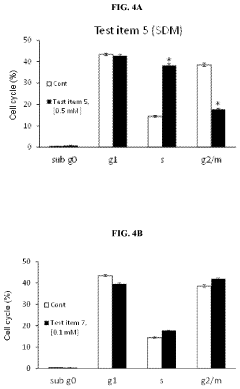How to Implement Hypertonic Solutions in Cosmetic Treatments?
Hypertonic Solutions in Cosmetics: Background and Objectives
Hypertonic solutions have emerged as a significant innovation in the field of cosmetic treatments, offering a novel approach to addressing various skin concerns. The concept of hypertonicity in cosmetics stems from the fundamental principles of osmosis and cellular biology. Over the past decade, researchers and cosmetic formulators have been exploring the potential of hypertonic solutions to enhance the efficacy of skincare products and treatments.
The primary objective of implementing hypertonic solutions in cosmetic treatments is to leverage the osmotic pressure differential between the solution and skin cells. This pressure gradient facilitates the movement of water out of the cells, leading to a temporary reduction in cell volume. This process can result in immediate visible effects, such as the reduction of puffiness and the appearance of fine lines.
As the cosmetic industry continues to evolve, there has been a growing demand for non-invasive treatments that provide rapid, visible results. Hypertonic solutions align perfectly with this trend, offering a bridge between traditional topical treatments and more invasive procedures. The technology behind these solutions has progressed from simple salt-based formulations to complex blends incorporating various osmolytes and active ingredients.
The development of hypertonic solutions for cosmetic use has been influenced by advancements in dermatology and pharmaceutical sciences. Early applications focused primarily on reducing localized edema and improving skin texture. However, recent research has expanded the potential applications to include enhancing the delivery of active ingredients, promoting skin barrier function, and even modulating cellular processes related to aging.
One of the key challenges in the implementation of hypertonic solutions has been achieving a balance between efficacy and skin tolerance. Formulators have had to navigate the delicate task of creating solutions that are sufficiently hypertonic to produce desired effects without causing irritation or compromising skin health. This has led to the exploration of various osmolytes beyond simple salts, including sugars, amino acids, and other biocompatible compounds.
The trajectory of hypertonic solution development in cosmetics has been marked by several significant milestones. These include the introduction of the first commercially successful hypertonic eye gels, the development of hypertonic facial masks, and the integration of hypertonic principles into daily skincare routines. Each of these advancements has contributed to a broader understanding of how osmotic forces can be harnessed for cosmetic benefits.
Looking ahead, the objectives for further development of hypertonic solutions in cosmetics are multifaceted. Researchers aim to enhance the precision of osmotic effects, targeting specific skin layers or cellular processes. There is also a focus on developing smart delivery systems that can respond to skin conditions in real-time, adjusting the osmotic pressure as needed. Additionally, efforts are being made to combine hypertonic principles with other cutting-edge technologies, such as microencapsulation and bioactive peptides, to create more comprehensive and effective cosmetic treatments.
Market Analysis for Hypertonic Cosmetic Treatments
The market for hypertonic cosmetic treatments has been experiencing significant growth in recent years, driven by increasing consumer demand for advanced skincare solutions and non-invasive aesthetic procedures. This segment of the cosmetics industry is characterized by its use of high-concentration solutions to address various skin concerns, particularly dehydration, aging, and skin texture issues.
The global market for hypertonic cosmetic treatments is estimated to be valued at several billion dollars, with a compound annual growth rate (CAGR) projected to be in the high single digits over the next five years. This growth is primarily fueled by the rising popularity of minimally invasive cosmetic procedures and the increasing awareness of advanced skincare technologies among consumers.
Key market drivers include the aging population in developed countries, growing disposable incomes in emerging markets, and a cultural shift towards preventative skincare routines. The trend of "tweakments" - subtle, non-surgical cosmetic enhancements - has also contributed to the increased adoption of hypertonic treatments in professional settings.
Geographically, North America and Europe currently dominate the market, accounting for a substantial portion of global revenue. However, the Asia-Pacific region is expected to witness the fastest growth, driven by increasing urbanization, rising beauty consciousness, and the influence of social media on beauty standards.
The consumer base for hypertonic cosmetic treatments is diverse but primarily consists of middle to high-income individuals aged 25-65. Women remain the primary consumers, but there is a growing trend of male consumers entering the market, particularly in urban areas and among younger demographics.
In terms of distribution channels, professional skincare clinics and medspas are the primary points of service for hypertonic treatments. However, there is a growing trend towards at-home treatments, with companies developing consumer-grade products that incorporate hypertonic technology for personal use.
The competitive landscape is characterized by a mix of established cosmeceutical companies and innovative startups. Major players are investing heavily in research and development to create more effective and targeted hypertonic solutions. There is also a trend towards the integration of hypertonic treatments with other skincare technologies, such as microneedling and LED therapy, to enhance overall efficacy.
Challenges in the market include regulatory hurdles, particularly for products that blur the line between cosmetics and medical treatments. Additionally, there is a need for consumer education to differentiate hypertonic treatments from other skincare options and justify their premium pricing.
Looking ahead, the market for hypertonic cosmetic treatments is expected to continue its growth trajectory, with opportunities for expansion in emerging markets and through product innovation. The integration of artificial intelligence and personalized skincare solutions is likely to shape the future of this market segment.
Current Challenges in Hypertonic Solution Implementation
The implementation of hypertonic solutions in cosmetic treatments faces several significant challenges that need to be addressed for successful integration and optimal results. One of the primary obstacles is achieving the right balance of osmotic pressure without causing excessive dehydration or irritation to the skin. Hypertonic solutions, by definition, have a higher solute concentration than the surrounding tissue, which can lead to rapid water loss from cells if not carefully controlled.
Another challenge lies in the formulation stability of hypertonic solutions. These solutions often contain high concentrations of active ingredients or osmolytes, which can affect the overall stability of the product. Ensuring that the solution remains stable over time, without precipitation or phase separation, is crucial for maintaining efficacy and shelf life.
The penetration of hypertonic solutions through the skin barrier presents an additional hurdle. The stratum corneum, the outermost layer of the skin, acts as a protective barrier that can limit the absorption of topically applied substances. Developing delivery systems that enhance the penetration of hypertonic solutions without compromising skin integrity is a complex task that requires innovative approaches.
Furthermore, the potential for adverse reactions and skin sensitivity is a significant concern. Hypertonic solutions can cause temporary discomfort, redness, or irritation, especially in individuals with sensitive skin or pre-existing skin conditions. Mitigating these side effects while maintaining the therapeutic benefits of the treatment is a delicate balance that cosmetic formulators must strike.
The regulatory landscape also poses challenges for implementing hypertonic solutions in cosmetic treatments. Depending on the jurisdiction, certain concentrations or combinations of ingredients may be subject to stricter regulations or may even be classified as drugs rather than cosmetics. Navigating these regulatory requirements while developing effective treatments can be complex and time-consuming.
Lastly, there is the challenge of consumer education and acceptance. Many consumers may be unfamiliar with the concept of hypertonic solutions and their benefits in skincare. Overcoming misconceptions and effectively communicating the science behind these treatments is essential for market adoption and success.
Existing Hypertonic Treatment Methodologies
01 Medical applications of hypertonic solutions
Hypertonic solutions are used in various medical applications, including treatment of edema, intracranial pressure reduction, and as a component in wound healing therapies. These solutions can help draw excess fluid from tissues and promote osmotic balance in the body.- Medical applications of hypertonic solutions: Hypertonic solutions are used in various medical applications, including treatment of edema, intracranial pressure reduction, and as a component in wound healing therapies. These solutions can help draw excess fluid from tissues and promote osmotic balance in the body.
- Formulation of hypertonic solutions for specific treatments: Hypertonic solutions are formulated with specific concentrations and compositions for targeted treatments. These may include saline solutions, sugar-based solutions, or combinations of electrolytes designed to address particular medical conditions or physiological imbalances.
- Use of hypertonic solutions in cell culture and preservation: Hypertonic solutions play a crucial role in cell culture techniques and preservation of biological samples. They are used to maintain osmotic balance, prevent cell lysis, and optimize conditions for cell growth and storage.
- Hypertonic solutions in food and beverage industry: The food and beverage industry utilizes hypertonic solutions for various purposes, including food preservation, flavor enhancement, and texture modification. These solutions can help extend shelf life and improve product quality through osmotic effects.
- Development of novel hypertonic solution delivery systems: Researchers are developing innovative delivery systems for hypertonic solutions to improve their efficacy and targeted application. These may include controlled release mechanisms, specialized containers, or combination with other therapeutic agents for enhanced treatment outcomes.
02 Formulation of hypertonic solutions for specific treatments
Hypertonic solutions are formulated with specific concentrations and compositions for targeted treatments. These may include saline solutions, sugar-based solutions, or combinations of electrolytes designed to address particular medical conditions or physiological imbalances.Expand Specific Solutions03 Use of hypertonic solutions in cell culture and preservation
Hypertonic solutions play a crucial role in cell culture techniques and preservation of biological samples. They can be used to maintain osmotic balance, induce cellular responses, or protect cells during cryopreservation processes.Expand Specific Solutions04 Hypertonic solutions in food and beverage industry
The food and beverage industry utilizes hypertonic solutions for various purposes, including preservation, flavor enhancement, and texture modification. These solutions can help extend shelf life and improve the overall quality of food products.Expand Specific Solutions05 Development of novel hypertonic solution delivery systems
Researchers are developing innovative delivery systems for hypertonic solutions to improve their efficacy and targeted application. These may include controlled release mechanisms, specialized containers, or combination with other therapeutic agents for enhanced treatment outcomes.Expand Specific Solutions
Key Players in Hypertonic Cosmetic Solutions
The implementation of hypertonic solutions in cosmetic treatments is currently in a growth phase, with increasing market size and technological advancements. The global market for such treatments is expanding rapidly, driven by growing consumer demand for non-invasive cosmetic procedures. Technologically, the field is progressing from early-stage development to more refined applications, with companies like Galderma International SAS, Shiseido Co., Ltd., and Allergan, Inc. leading the way. These industry leaders are investing heavily in research and development to improve the efficacy and safety of hypertonic solutions. Emerging players such as Revance Therapeutics, Inc. and Azura Ophthalmics Pty Ltd. are also contributing to the technological maturation of this field, introducing innovative approaches and formulations. The competitive landscape is characterized by a mix of established pharmaceutical companies and specialized cosmetic firms, all vying to capture market share in this promising sector.
Shiseido Co., Ltd.
Allergan, Inc.
Innovative Formulations for Hypertonic Solutions
- A composition comprising a selenium-containing amino acid, such as selenium methionine or selenium cysteine, is used as a keratolytic agent in topical formulations for dermatological or cosmetic use, potentially combined with other agents like salicylic acid or pressure-sensitive adhesives, to treat hyperkeratosis disorders by softening keratin and inhibiting cell proliferation.
- A dermatological composition combining hydroquinone, tretinoin, and fluocinolone acetonide, applied topically, which effectively treats hyperpigmentation by depigmenting pathological scars, improving their appearance and suppleness, and is compatible with skin tissues for safe use.
Safety and Efficacy Regulations for Hypertonic Cosmetics
The implementation of hypertonic solutions in cosmetic treatments necessitates strict adherence to safety and efficacy regulations. These regulations are designed to protect consumers and ensure the effectiveness of cosmetic products containing hypertonic solutions. Regulatory bodies such as the U.S. Food and Drug Administration (FDA) and the European Medicines Agency (EMA) play crucial roles in establishing and enforcing these guidelines.
Safety regulations for hypertonic cosmetics primarily focus on preventing adverse reactions and ensuring product stability. Manufacturers must conduct thorough safety assessments, including irritation and sensitization tests, to demonstrate that their products are safe for intended use. Additionally, preservative efficacy testing is required to ensure that hypertonic solutions maintain their integrity throughout the product's shelf life.
Efficacy regulations require cosmetic companies to provide substantial evidence supporting their product claims. This often involves conducting clinical trials and submitting data to regulatory authorities for review. For hypertonic solutions in cosmetics, efficacy claims may relate to skin hydration, wrinkle reduction, or other aesthetic improvements.
Labeling requirements for hypertonic cosmetics are stringent, mandating clear disclosure of active ingredients, concentrations, and potential side effects. Warning statements may be necessary for products with higher osmotic potential, particularly those intended for use around sensitive areas such as the eyes.
Quality control measures are essential in the production of hypertonic cosmetics. Manufacturers must implement Good Manufacturing Practices (GMP) to ensure consistent product quality and safety. This includes regular testing of raw materials, in-process controls, and finished product analysis to verify osmolality and other critical parameters.
Post-market surveillance is another crucial aspect of regulatory compliance for hypertonic cosmetics. Companies are required to monitor and report adverse events associated with their products, allowing regulatory agencies to identify and address potential safety issues promptly.
As the cosmetic industry continues to innovate with hypertonic solutions, regulatory frameworks are evolving to keep pace. Emerging regulations may address novel delivery systems, combination products, or specific applications of hypertonic solutions in cosmetic treatments. Staying informed about these regulatory developments is essential for companies operating in this space.
Environmental Impact of Hypertonic Solution Production
The production of hypertonic solutions for cosmetic treatments has significant environmental implications that warrant careful consideration. The manufacturing process often involves the use of various chemicals and compounds, which can lead to potential environmental hazards if not properly managed. One of the primary concerns is the generation of wastewater containing high concentrations of salts and other solutes. This effluent, if released untreated, can disrupt local ecosystems and harm aquatic life.
Furthermore, the energy consumption associated with the production of hypertonic solutions contributes to carbon emissions and overall environmental impact. The processes of purification, sterilization, and packaging require substantial energy inputs, often derived from non-renewable sources. This energy-intensive production cycle raises questions about the sustainability of large-scale hypertonic solution manufacturing for cosmetic applications.
The sourcing of raw materials for hypertonic solutions also presents environmental challenges. Many ingredients are derived from natural resources, which may lead to habitat destruction or overexploitation if not sustainably managed. For instance, the extraction of certain minerals or plant-based compounds used in these solutions can result in soil degradation, deforestation, or disruption of local ecosystems.
Packaging is another critical aspect of environmental concern. The cosmetic industry often relies on single-use plastic containers for hypertonic solutions, contributing to the global plastic waste crisis. The disposal of these containers, especially if not properly recycled, can lead to long-term environmental pollution and harm to wildlife.
Water usage is a significant factor in the production of hypertonic solutions. The process requires large volumes of purified water, which can strain local water resources, particularly in water-scarce regions. This high water demand raises questions about the sustainability of production in areas facing water stress or scarcity.
To mitigate these environmental impacts, the cosmetic industry is exploring more sustainable production methods. These include implementing closed-loop water systems to reduce wastewater discharge, adopting renewable energy sources for manufacturing processes, and developing eco-friendly packaging alternatives. Some companies are also investigating the use of bio-based ingredients and green chemistry principles to minimize the environmental footprint of hypertonic solution production.
Regulatory bodies are increasingly focusing on the environmental impact of cosmetic production, including hypertonic solutions. This has led to stricter guidelines on waste management, emissions control, and sustainable sourcing practices. As consumer awareness grows, there is also a rising demand for environmentally responsible cosmetic products, pushing manufacturers to adopt more sustainable production methods for hypertonic solutions.



